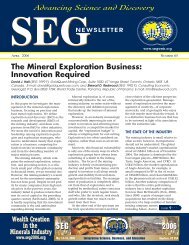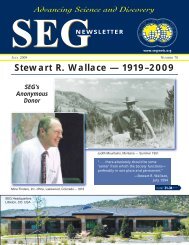SEG 45 Final_qx4 - Society of Economic Geologists
SEG 45 Final_qx4 - Society of Economic Geologists
SEG 45 Final_qx4 - Society of Economic Geologists
Create successful ePaper yourself
Turn your PDF publications into a flip-book with our unique Google optimized e-Paper software.
4 <strong>SEG</strong> NEWSLETTER No 63 • OCTOBER 2005<br />
... from the Cover<br />
the subject. In a memorial, published in<br />
the Proceedings <strong>of</strong> the GSA for 1968,<br />
Jack Green writes <strong>of</strong> Spurr’s original<br />
ideas about the moon. “…behind every<br />
sketch was 50 years <strong>of</strong> field training.<br />
Behind every analogue were decades <strong>of</strong><br />
mapping and observation.” Spurr’s<br />
work has been recognized by the naming<br />
<strong>of</strong> a lunar feature after him. At<br />
Lunar latitude 27.9 N and longitude 1.2<br />
W, adjacent to the landing site <strong>of</strong><br />
Apollo 15, is Spurr crater, 13 km in<br />
diameter and partially covered by lava.<br />
Spurr is credited with the suggestions<br />
that led to the founding <strong>of</strong> the <strong>Society</strong> <strong>of</strong><br />
<strong>Economic</strong> <strong>Geologists</strong> in 1920, and was<br />
<strong>Society</strong> President in 1923. His Presidential<br />
Address on “The Origin <strong>of</strong><br />
Metallic Concentrations by Magmation”<br />
is published on pages 617 to 638 <strong>of</strong><br />
Volume 18 <strong>of</strong> <strong>Economic</strong> Geology.<br />
Frederick Leslie Ransome,<br />
1868–1935<br />
The first Secretary to<br />
the Board <strong>of</strong> the<br />
<strong>Economic</strong> Geology<br />
Publishing Company,<br />
and for 30 years, to the<br />
day <strong>of</strong> his death, an<br />
Associate Editor,<br />
Ransome was a<br />
devoted and hardworking<br />
member <strong>of</strong> the small group <strong>of</strong><br />
people who founded and nurtured<br />
<strong>Economic</strong> Geology to the stature it has<br />
attained.<br />
Born in England but brought to the<br />
United States in infancy, Ransome grew<br />
up in California, where his father was a<br />
concrete pioneer, building the first concrete<br />
building and first concrete bridge<br />
in America. When Ransome entered the<br />
University <strong>of</strong> California, Berkeley, there<br />
seemed little chance he would become a<br />
geologist. But in 1890, Andrew C.<br />
Lawson, fresh from his PhD at Johns<br />
Hopkins, arrived and fired Ransome’s<br />
ambitions. Ransome graduated in 1893<br />
and stayed on to complete a PhD in<br />
1896. During that time he and Charles<br />
Palache worked on a mineral they discovered<br />
in the glaucophane schists <strong>of</strong><br />
Marin County—it turned out to be new<br />
and they named it lawsonite.<br />
Ransome joined the U.S. Geological<br />
Survey in 1898 and was assigned to<br />
California, where he worked on the<br />
Mother Lode—the results appeared in<br />
The Founders <strong>of</strong> <strong>Economic</strong> Geology (Continued)<br />
1900 in USGS Atlas folio number 63.<br />
From there he moved to Arizona, where<br />
be studied Globe and Bisbee, published<br />
in Pr<strong>of</strong>essional Papers 12 and 21,<br />
respectively. In 1904 he began a collaborative<br />
study with Lindgren <strong>of</strong> the<br />
Cripple Creek district, the result <strong>of</strong><br />
which is one <strong>of</strong> the classics <strong>of</strong> American<br />
geology, Pr<strong>of</strong>essional Paper 54. When<br />
Ransome joined the Survey he worked<br />
under the supervision <strong>of</strong> S.F. Emmons;<br />
following Emmons death in 1911,<br />
Lindgren succeeded as chief <strong>of</strong> the metals<br />
division. Then, when Lindgren<br />
became Chief Geologist in 1912,<br />
Ransome became head <strong>of</strong> metals, a<br />
position he held until he left the Survey<br />
in 1923 and moved to the University <strong>of</strong><br />
Arizona in Tucson as pr<strong>of</strong>essor <strong>of</strong> economic<br />
geology. Four years later he<br />
moved again when he was appointed to<br />
a similar position at California Institute<br />
<strong>of</strong> Technology in Pasadena, California.<br />
Ransome was President <strong>of</strong> the <strong>Society</strong><br />
<strong>of</strong> <strong>Economic</strong> <strong>Geologists</strong> in 1927. His<br />
Presidential address on “Directions <strong>of</strong><br />
Progress in <strong>Economic</strong> Geology” can be<br />
read in volume 23 <strong>of</strong> the journal, pages<br />
119 to 131.<br />
Waldemar Lindgren,<br />
1860–1939<br />
Lindgren is probably<br />
the most familiar<br />
name among the<br />
founders <strong>of</strong> <strong>Economic</strong><br />
Geology. It is familiar<br />
because <strong>of</strong> the breadth<br />
and depth <strong>of</strong> his writings<br />
and because <strong>of</strong><br />
his impact on the<br />
development <strong>of</strong> economic geology as a<br />
field <strong>of</strong> study and scientific investigation.<br />
Born in the southeast corner <strong>of</strong><br />
Sweden, near Kalmar, Lindgren was<br />
raised in a well-to-do and aristocratic<br />
family. Much attention was paid to his<br />
education and he developed a fluency<br />
in several modern languages—training<br />
that served him well in later life, even<br />
though his interests were more with science<br />
than languages. A brief working<br />
experience at the zinc mines at Ämmeberg<br />
at the end <strong>of</strong> high school convinced<br />
him that geology was his calling,<br />
and he entered the Bergakademie<br />
at Freiberg, Saxony, in 1878. A brief discussion<br />
<strong>of</strong> his training at this famous<br />
Photo Source: Library <strong>of</strong> Congress, Washington, DC<br />
old school was published in <strong>SEG</strong><br />
Newsletter number 43, October 2000,<br />
pages 30 to 32.<br />
After graduation as a mining engineer<br />
and surveyor and a further year<br />
spent studying chemistry and petrography,<br />
Lindgren sailed to United States<br />
and landed a job working under the<br />
direction <strong>of</strong> Raphael Pumpelly on the<br />
Northern Transcontinental Survey. On<br />
completion <strong>of</strong> the survey at the end <strong>of</strong><br />
1883, he worked as an assayer in<br />
Montana, then on smelter design at<br />
Anaconda. At the end <strong>of</strong> 1884, on the<br />
recommendation <strong>of</strong> Pumpelly, he joined<br />
the U.S. Geological Survey as a member<br />
<strong>of</strong> the staff <strong>of</strong> George F. Becker. He<br />
remained with the Survey for 31 years,<br />
rising to Chief Geologist in 1911.<br />
During his Survey years, Lindgren was<br />
author or co-author <strong>of</strong> a number <strong>of</strong><br />
classic papers and monographs. Among<br />
the classics is the first detailed study <strong>of</strong> a<br />
disseminated, or porphyry copper at<br />
Clifton-Morenci in Arizona, published<br />
in USGS Pr<strong>of</strong>essional Paper 43 in 1905,<br />
and in 1906, with F.L. Ransome, the<br />
Cripple Creek, Colorado Pr<strong>of</strong>essional<br />
Paper 54.<br />
Lindgren was appointed pr<strong>of</strong>essor <strong>of</strong><br />
economic geology at the Massachusetts<br />
Institute <strong>of</strong> Technology in 1912, in<br />
which position he remained until his<br />
retirement in 1933. The work for which<br />
Lindgren is best known was published<br />
soon after he arrived at MIT, his classic<br />
text Mineral Deposits. The text ran<br />
through four editions, the last in 1933,<br />
and was the standard against which all<br />
other texts in economic geology were<br />
measured for the first half <strong>of</strong> the 20 th<br />
century. Lindgren’s thoughts and ideas<br />
continue to pervade the literature <strong>of</strong><br />
economic geology today.<br />
Lindgren was a founding member<br />
<strong>of</strong> both the <strong>Economic</strong> Geology<br />
Publishing Company and the <strong>Society</strong><br />
<strong>of</strong> <strong>Economic</strong> <strong>Geologists</strong>. He was second<br />
President <strong>of</strong> the <strong>Society</strong>, in 1922. His<br />
Presidential address on “Concentration<br />
and Circulation <strong>of</strong> the Elements from<br />
the Standpoint <strong>of</strong> <strong>Economic</strong> Geology”<br />
can be read in volume 18 <strong>of</strong> <strong>Economic</strong><br />
Geology, pages 419 to 442. The paper<br />
is an attempt to trace the geochemical<br />
cycling <strong>of</strong> a number <strong>of</strong> chemical<br />
elements, and is a fascinating insight<br />
into the thoughts <strong>of</strong> a seminal<br />
scientist. 1






